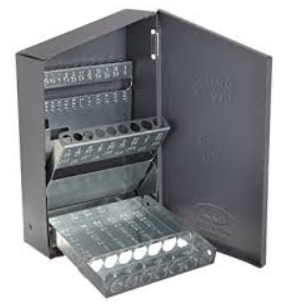Does anybody have any idea why the traditional metal drill indexes arranges with largest drills and the labels toward the outside?
The result is that you can't just flip up all the panels, search for the label you want, then pull out the drill. You can only do so for the first panel with the largest drills.
For all other panels you need to lay the panel down so you can see the labels, then flip the panel up and grab the drill. Then you have to double check the marking on the drill shank (which I suppose you should do anyways), because when you flip up the index to grab the drill you can't see the labels anymore and it's really easy to grab the wrong drill for the smaller sizes when there are a great many next to each other. For the smaller drills you can't even check because the shank is too small to even have a label.
The first time I used an index I did think it was kind of weird and inconvenient. But then I got used to it and never gave it much thought until I ran into one of the newer drill indexes that actually allows for this, which incidentally also pull up all the panels for you when you open the lid. Kinda nice.


EDIT: My god, I just found out the stopper plate in the plastic drill case is made to be removable and the case has little knobs to lock the plate at varying heights for drills of varying lengths. Whoever designed this is brilliant. Too bad it's plastic. The metal index doesn't have this. The only thing I don't like is these drill indexes don't have stamped labels, not even the metal version.

